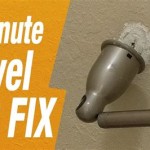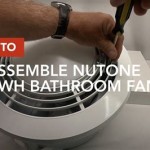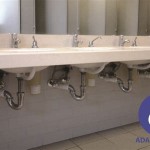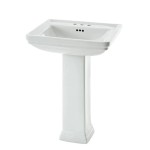Which Way to Install Bathroom Grab Bars: A Comprehensive Guide
Bathroom grab bars are essential safety fixtures, particularly beneficial for individuals with mobility limitations, seniors, or anyone seeking added security in potentially slippery bathroom environments. Proper installation is paramount to ensure the grab bar provides reliable support and prevents accidents. This article outlines the critical steps and considerations for installing bathroom grab bars correctly.
Understanding Grab Bar Types and Placement
Before commencing installation, it is crucial to understand the different types of grab bars available and to plan their strategic placement. Grab bars come in various shapes, sizes, and materials, each suited for specific needs and locations. Common types include straight bars, angled bars, and flip-up bars. Straight bars are versatile and suitable for general support near toilets, showers, and bathtubs. Angled bars offer ergonomic grip options, especially helpful for transitioning between sitting and standing. Flip-up bars provide support near toilets and can be conveniently folded away when not needed.
Placement is dictated by the user’s needs and the bathroom layout. Consider the user's typical movements within the bathroom. For example, near the toilet, a grab bar positioned horizontally or diagonally can assist with sitting down and standing up. In the shower or bathtub, vertical bars may be positioned to aid in stability while showering or bathing, while horizontal bars can assist with entering and exiting. ADA (Americans with Disabilities Act) guidelines offer useful reference points for recommended heights and locations for grab bars in accessible bathrooms. However, prioritize the specific needs and preferences of the individual who will be using the grab bars. Consider consulting with an occupational therapist or accessibility specialist for personalized recommendations.
It is also essential to consider the user's reach and strength. Place the grab bar within easy reach and at a height that provides adequate support. Perform mock trials, having the user mimic their usual movements in the bathroom, to determine the optimal placement. Use painter’s tape to mark potential locations before drilling any holes. This allows for adjustments and ensures the final placement is suitable.
Identifying Wall Studs and Reinforcement
Securely anchoring the grab bar to wall studs is the most critical aspect of installation. Wall studs provide the necessary structural support to withstand the force and weight applied to the grab bar. Using a stud finder, carefully locate the wall studs behind the finished wall surface (e.g., drywall, tile). Stud finders are electronic devices that detect changes in density within the wall, indicating the presence of a stud. Calibrate the stud finder according to the manufacturer's instructions for optimal accuracy.
Once the studs are located, mark their precise center with a pencil. To verify the stud's location, drive a small nail or screw through the wall at the marked point. If the nail or screw encounters solid wood, the stud has been located. If it encounters no resistance, the stud finder may have been inaccurate, or the marking may be slightly off. Repeat the process until the stud’s precise location is confirmed.
If ideal grab bar placement does not align with the location of wall studs, alternative reinforcement methods are necessary. One option is to install a wooden blocking between the studs. This involves cutting a piece of lumber (e.g., a 2x6) to fit snugly between the studs, securing it with screws. This blocking then provides a solid surface for attaching the grab bar. Access to the interior wall cavity is required for this method, potentially necessitating cutting and patching the drywall or tile. Another option is to use specialized grab bar anchors designed for use without studs. These anchors expand within the wall to provide a secure hold. However, it is crucial to select anchors rated for the expected weight and force. Consult the manufacturer's instructions and always err on the side of caution when selecting these anchors.
In tile installations, special considerations are required. Drilling through tile can be challenging and may result in cracking or chipping. Use a carbide-tipped drill bit specifically designed for tile. Apply masking tape over the drilling location to minimize chipping. Start drilling slowly and steadily, applying gentle pressure. Avoid using excessive force, which can damage the tile. Once the tile has been penetrated, switch to a standard drill bit appropriate for the material behind the tile (e.g., wood for studs or drywall for anchors).
Step-by-Step Installation Process
After determining the grab bar type, placement, and reinforcement method, the actual installation can begin. Gather the necessary tools and materials, including a stud finder, level, drill, drill bits (tile and wood/metal), screwdriver or power drill with appropriate bits, measuring tape, pencil, safety glasses, and the grab bar mounting hardware.
First, position the grab bar against the wall at the marked location. Use a level to ensure the bar is horizontally or vertically aligned, depending on the intended orientation. Mark the locations of the mounting holes on the wall using a pencil. If using wall studs, ensure the marked holes align with the center of the studs. If using alternative anchors, follow the anchor manufacturer's instructions for hole placement.
Next, drill pilot holes at the marked locations. When drilling through tile, remember the precautions mentioned earlier. For studs, drill pilot holes slightly smaller than the diameter of the mounting screws. For anchors, drill holes according to the anchor manufacturer’s specifications. Ensure the pilot holes are deep enough to accommodate the length of the mounting screws or anchors.
Position the grab bar back against the wall, aligning the mounting holes with the pilot holes. Insert the mounting screws or anchors through the mounting flanges of the grab bar and into the pilot holes. Tighten the screws or anchors securely. If using screws, avoid over-tightening, which can strip the screw holes. If using anchors, follow the manufacturer's instructions for proper installation and tightening.
Once the grab bar is installed, thoroughly test its stability. Apply force to the bar in various directions to ensure it is securely anchored and does not move or wobble. If any movement is detected, re-tighten the screws or anchors or consider using larger screws or a different type of anchor. If the grab bar is still unstable, the reinforcement method may be inadequate, and alternative measures may be required.
After confirming the grab bar's stability, conceal the mounting hardware. Most grab bars come with escutcheons or covers that snap over the mounting flanges to conceal the screws or anchors. Install these covers according to the manufacturer's instructions. Inspect the surrounding area for any damage caused during the installation process, such as chipped tile or scratched wall paint. Repair any damage as needed to restore the bathroom's appearance.
Regularly inspect the grab bars for any signs of loosening or damage. Re-tighten screws or replace anchors as needed to maintain the grab bar's stability. A properly installed and maintained grab bar provides a valuable safety aid, reducing the risk of falls and enhancing independence in the bathroom environment.

Proper Shower Grab Bar Placement Keeps Your Family Safe Improveit

Proper Shower Grab Bar Placement Keeps Your Family Safe Improveit

Where Should Toilet Grab Bars Be Installed Freedom Showers

Installing Grab Bars In Your Bathroom A Complete Guide

How And Where To Install Bathroom Safety Rails Grab Bars

Grab Bar Placement Guides Grabbars Com

How High Should Grab Bars Be Installed Right Bar Height

Ada Toilet Grab Bar Placement Guide Commercial Grabbars Com

Grab Bar Installation Hunker Bars In Bathroom Shower

Shower Grab Bar Install 101 Home Fixated
Related Posts







